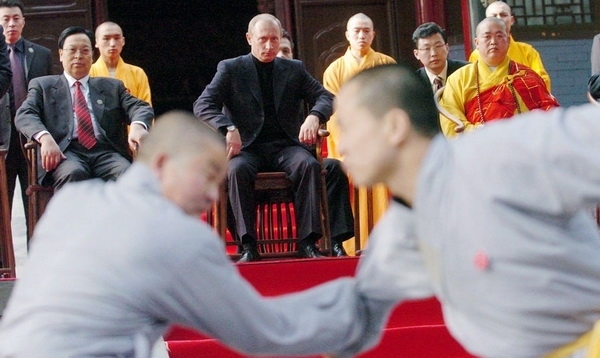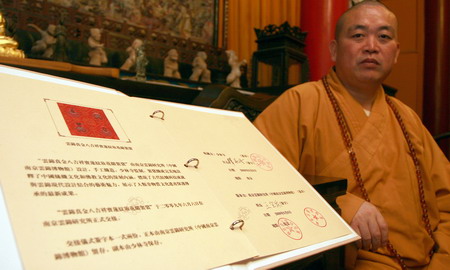He says the iPad and other gadgets are all gifts from devotees but that he tries to use such things until they are broken and unusable before replacing them. “I’m not doing what I do for other people but for society, for the masses; it’s not for me personally or for the local government but if there is a need in society or among the ordinary folk, then I should do what I can.”
Samadhi restaurant
Shaolin Temple,Henan Province, China
‘Three treasures to welcome guests’: with bran, pickled radish and shredded dried tofu
‘Vegetarian shark fin soup’: with pumpkin and bean flour noodles
‘Rose salad roll’: spring rolls with melon, radish and vegetarian ham
‘Floating fragrance in a Buddhist pot’: with cabbage and tofu
‘Blossoming smile of enlightenment’: with fried eggplants, tofu, vegetables
’Buddha jumps over the wall with Zen in his heart’: oily soup with ginseng, mushrooms, wolfberry
Set menu price: approx £80 per person
(After negotiations that lasted almost an hour, I was allowed to pay the bill, as per the rules of the Lunch with the FT. This was a breach of Chinese etiquette but the transgression was eventually forgiven)
We tuck into a dish of cabbage and shredded dried tofu with the delightful name of “floating fragrance in a Buddhist pot” but I notice that the abbot is hardly touching his food. The mention of his dealings with the local government is an illustration of the difficult relationship in China between organised religion and the officially atheist ruling Communist party. The Chinese government only recognises five official religions – Daoism, Buddhism, Islam, Catholicism and Protestantism – and requires that these be organised into institutions supervised by “patriotic associations”, in turn supervised by the State Administration for Religious Affairs and the Communist party’s United Front department.
Other world religions, such as Orthodox Christianity, Judaism, Mormonism or Baha’i, are not recognised by Beijing, and nor are countless underground Catholic and Protestant “house churches”. The government tends to tolerate much of this “unofficial” religious activity as long as it is a private matter, but any hint of political organisation will bring a crackdown.
The Shaolin abbot doesn’t need to worry about this. He has been a member of the National People’s Congress, the country’s rubber-stamp parliament, since 1998 and vice-chairman of the official Buddhist Association of China since 2002. Ordinarily, the abbot and other senior monks at the temple will decide who can be ordained as a monk and the temple will then register them with the provincial religious affairs bureau. But the position of abbot must be directly authorised by the religious affairs authorities, almost all of whom are atheist Communist party members.
I ask his eminence why he thinks he was chosen and his answer is simple: “Because I am obedient. I’m willing to donate myself and serve the people.” To “serve the people” is a traditional communist slogan that regularly trips off the tongue of party bureaucrats. He explains that this subservience of religion to the state has always existed in China and in many other countries as well. “Throughout history it is the same: religion must respect the emperor, respect the government. If a religion doesn’t respect the government, it will have difficulty surviving,” he says. “We have to rely on the government to publicise and promote us. The government has a lot of power and it’s difficult to promote ourselves without it.”
There he goes again, speaking like an executive from a global marketing firm.
As the waiters place a fried eggplant and tofu dish called “blossoming smile of enlightenment” in front of us, I ask him how he responds to the critics who say he is too fond of mixing the sacred and the profane.
“Our aim is to promote Buddhist culture, to baptise human souls and purify people’s minds,” the abbot says. “What we have done so far [in terms of commercialisation] is actually quite conservative because we don’t want to get too mixed up in the affairs of society or over-exploit Shaolin Temple.” He describes how a proposal in 2009 by the local government to list the temple on a domestic or international stock exchange was abandoned after he and the other monks voiced strong objections.
On the abbot’s instructions, the flow of dishes has slowed and most of his plates have been cleared without him tasting more than a spoonful or two. Throughout our lunch it feels as if he is trying to convince me that he is not the materialistic villain he is often portrayed as in China. More than once he mentions the fact that he and each of his monks live a plain existence, normally surviving on just Rmb 7 (70p) per day.
His explanation of the pressures he faces in a modern Chinese society is, however, persuasive. “We hope we can improve the bad atmosphere of modern society through the influence of the Shaolin Temple; over the years we have seen society pollute the earth and overexploit resources and people’s desires continuously grow,” he says. “We wish everyone could lead a simple life like us monks and not chase after famous brands and luxury lifestyles in the way the awful nouveau riche in our country do.”
One of the last dishes is laid in front of us and the abbot breaks into a beatific smile in appreciation at the irony of its name. It is a vegetarian version of “Buddha jumps over the wall”, an oily soup that usually includes meat and seafood and is supposed to taste so good that it can tempt even devout monks to jump the monastery wall and renounce their monastic vows.
“See, that shows you how open and sympathetic Chinese Buddhism is,” he says. “In other cultures or religions, if somebody used this kind of name for such a sacrilegious dish there would be a huge fight.”
Coming from a religion where monks who have sworn not to harm sentient beings wield swords and practise cracking skulls with their fists, this too is persuasive. For the abbot, temporal dealings – including business – appear merely a necessary diversion on the path towards enlightenment.
Jamil Anderlini is the FT’s Beijing bureau chief
To see a video of the Shaolin Temple and the abbot, go to
www.ft.com/shaolin
Timeline: A brief history of the Shaolin Temple
AD495 Shaolin Temple (literally “temple in the forests of Shaoshi mountain”) is built by Emperor Xiaowen of the Northern Wei dynasty as a place for the Indian monk Batuo to live, translate Buddhist scriptures and preach to his followers.
AD618-907 A band of 13 Shaolin monks is reputed to have saved the life of the future Tang dynasty Emperor Li Shimin. When Li took power, he showered favours, land and wealth on the temple and it experienced a golden age.
1368-1644 During the Ming dynasty, the temple houses more than 3,000 monks. It declines under the Manchurian Qing dynasty (1644-1911).
1928 Chinese warlord Shi Yousan attacks the temple and a fire rages for 40 days, destroying nearly all relics and records. Despite having been looted, burned and destroyed many times over the centuries, the temple has only been abandoned – briefly – in the seventh and tenth centuries.
1950s-1970s The temple’s lands are seized during the communist land redistributions and most monks driven away. During the cultural revolution that follows, the handful of monks who remain are beaten and persecuted or forced to renounce their vows.
1981 Shi Yongxin, born Liu Yingcheng, arrives at the Shaolin Temple to train as a monk.
1987 Begins running the temple after the previous abbot’s death. In 1998, he is selected as a representative to the National People’s Congress, China’s rubberstamp parliament.
1999 Ordained as the temple’s abbot.



 Reply With Quote
Reply With Quote









 I'm just sayin'........
I'm just sayin'........
